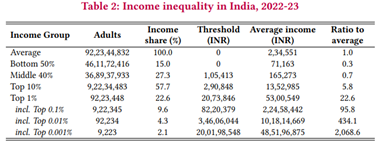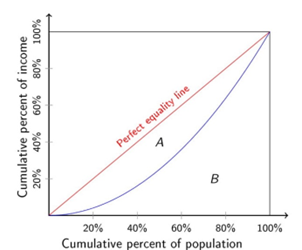Income inequality refers to how unevenly income is distributed throughout a population. The less equal the distribution, the greater the income inequality.
Measurement of Income Inequality
Lorenz Curve
-
- Graphical representation
- Relationship between cumulative percentage of income and percentage of population
- The Gini coefficient can be represented through Lorenz Curve.
Gini Coefficient
-
- Measures the degree of income inequality.
- Varies between 0 and 1
- 0 = Perfect Equality (Even distribution of income with respect to population distribution)
- 1 = Perfect Inequality (All income is earned by a single person)
- India’s Gini coefficient is about 0.357 and it is increasing which signifies increasing income inequality in India.
Recent Reports on Income Inequality
1. Oxfam International Report (Jan 2023)
-
- More than 40% of the wealth created in the country from 2012 to 2021 had gone to just 1% of the population.
- While only 3% had trickled down to the bottom 50%.
2. World Inequality Lab Report (2024)
-
- According to the report titled ‘Income and Wealth Inequality in India, 1922-2023: The Rise of the Billionaire Raj’, the wealth share of the top 1 percent of the population in India was as high as 40.1 percent in 2022-23.

Causes Of Wealth and Income Inequality in India
-
- Regressive Taxation Policies: Approximately 64% of the total goods and services tax (GST) in the country was collected from the bottom 50% of the population, while only 4% came from the top 10% of the income pyramid.
- Lack of Social Safety Nets: Inadequate social safety nets and welfare programs may leave vulnerable populations without sufficient support, widening the wealth gap. This also hinders their savings and wealth creation capabilities.
- Dominance of informal economy: A large informal sector characterized by limiting access to social protections, savings, and wealth-building opportunities for a significant portion of the population fuels income and wealth inequality. Wage gaps between skilled and unskilled workers are highly likely to contribute to income inequality.
- Historical and structural factors: Historical inequities, such as the caste system and colonial-era policies, have contributed to wealth disparities that persist today. These structural factors create barriers to economic opportunities and asset accumulation for marginalized communities.
- Unequal access to education and employment: Disparities in access to quality education and employment opportunities aggravate wealth inequality. Limited access to education and skills training hinders upward mobility, while discrimination in the job market exacerbates income gaps.
- Skewed land ownership: Unequal distribution of land and property rights, often influenced by historical injustices and land reforms, contributes significantly to wealth inequality. Wealthier individuals and corporations tend to have greater access to land and property, consolidating their economic advantage.
- Financial exclusion and lack of access to credit: Limited access to formal financial services and credit facilities disproportionately affects marginalized communities and small-scale entrepreneurs, hindering their ability to accumulate wealth and invest in productive assets.
- Globalisation and technological changes: Economic globalization and technological advancements have led to uneven distribution of benefits, with certain sectors and individuals accruing significant wealth while others face displacement and stagnant incomes.


